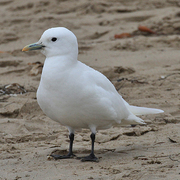Ivory Gull
The Washington representatives of this family can be split into two groups, or subfamilies. The adaptable gulls are the most familiar. Sociable in all seasons, they are mainly coastal, but a number of species also nest inland. Many—but not all—are found around people. Gulls have highly variable foraging techniques and diets. Terns forage in flight, swooping to catch fish or insects. They dive headfirst into the water for fish. Although they are likely to be near water, they spend less time swimming than gulls.
General Description
Ivory Gull is perhaps the most immediately recognizable gull in North America but unfortunately it also one of the least often seen. Small and white-plumaged, it has a black eye, black legs, and a two-toned black-and-yellow bill; immatures have small amounts of black spotting or streaking, including a narrow band on the end of the tail.
The Ivory Gull breeds right around the northern hemisphere but rarely ventures south of the Arctic Circle, nesting on boulder fields and rocky cliffs inland from the frozen sea and wintering mostly on pack ice. It regularly appears in Labrador and Newfoundland in late winter and early spring and is a rare winter visitor to the Maritime Provinces and the northeastern and midwestern United States. It is an exceedingly rare winter visitor in western North America. British Columbia has six records going back more than a century, the most recent of them in December 2001 at Delta, a few miles north of the U.S. border. Washington’s lone record is from Ocean Shores (Grays Harbor County) in December 1975. The only record farther south along the Pacific Coast was of a bird found dying in Orange County, California, in January 1996.
The estimated world population of Ivory Gull has been placed at somewhere between 20,000 and 50,000 birds, most of them breeding in the Old World with Canada and Greenland accounting for perhaps 10–20 percent of the total. However, recent surveys in Canada point to a dramatic decline in numbers. It is thought that by 2003 only about 300 birds remained in the country. Suggested causes for the population crash include global warming, which is rapidly altering the fragile ecology of the high Arctic; high concentrations of mercury in the gull’s eggs that may be negatively affecting its reproductive success; and disturbances resulting from industrial-scale exploitation of mineral resources within this species’ nesting and foraging territories. Ivory Gull has recently been added to Canada’s Endangered Species List.
Revised June 2007
Family Members
 Laughing GullLarus atricilla
Laughing GullLarus atricilla Franklin's GullLarus pipixcan
Franklin's GullLarus pipixcan Little GullLarus minutus
Little GullLarus minutus Black-headed GullLarus ridibundus
Black-headed GullLarus ridibundus Bonaparte's GullLarus philadelphia
Bonaparte's GullLarus philadelphia Heermann's GullLarus heermanni
Heermann's GullLarus heermanni Black-tailed GullLarus crassirostris
Black-tailed GullLarus crassirostris Short-billed GullLarus canus
Short-billed GullLarus canus Ring-billed GullLarus delawarensis
Ring-billed GullLarus delawarensis California GullLarus californicus
California GullLarus californicus Herring GullLarus argentatus
Herring GullLarus argentatus Thayer's GullLarus thayeri
Thayer's GullLarus thayeri Iceland GullLarus glaucoides
Iceland GullLarus glaucoides Lesser Black-backed GullLarus fuscus
Lesser Black-backed GullLarus fuscus Slaty-backed GullLarus schistisagus
Slaty-backed GullLarus schistisagus Western GullLarus occidentalis
Western GullLarus occidentalis Glaucous-winged GullLarus glaucescens
Glaucous-winged GullLarus glaucescens Glaucous GullLarus hyperboreus
Glaucous GullLarus hyperboreus Great Black-backed GullLarus marinus
Great Black-backed GullLarus marinus Sabine's GullXema sabini
Sabine's GullXema sabini Black-legged KittiwakeRissa tridactyla
Black-legged KittiwakeRissa tridactyla Red-legged KittiwakeRissa brevirostris
Red-legged KittiwakeRissa brevirostris Ross's GullRhodostethia rosea
Ross's GullRhodostethia rosea Ivory GullPagophila eburnea
Ivory GullPagophila eburnea Least TernSternula antillarum
Least TernSternula antillarum Caspian TernHydroprogne caspia
Caspian TernHydroprogne caspia Black TernChlidonias niger
Black TernChlidonias niger Common TernSterna hirundo
Common TernSterna hirundo Arctic TernSterna paradisaea
Arctic TernSterna paradisaea Forster's TernSterna forsteri
Forster's TernSterna forsteri Elegant TernThalasseus elegans
Elegant TernThalasseus elegans

